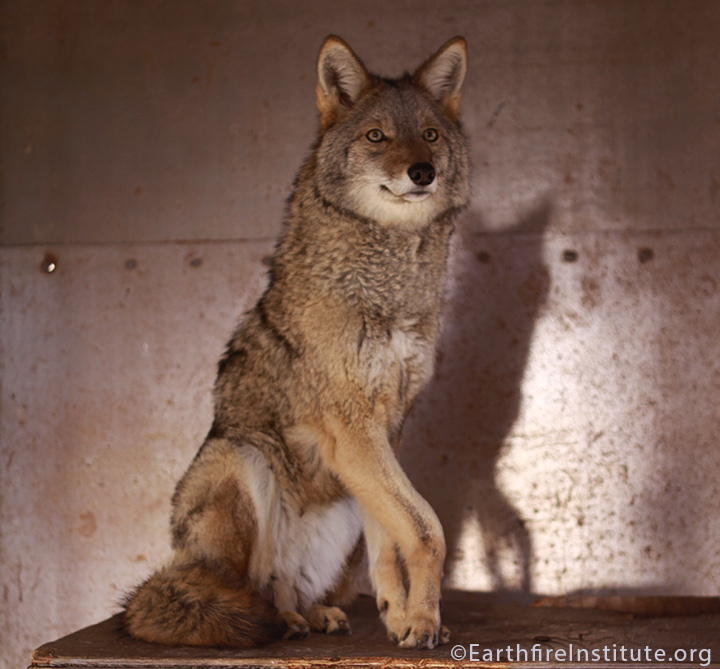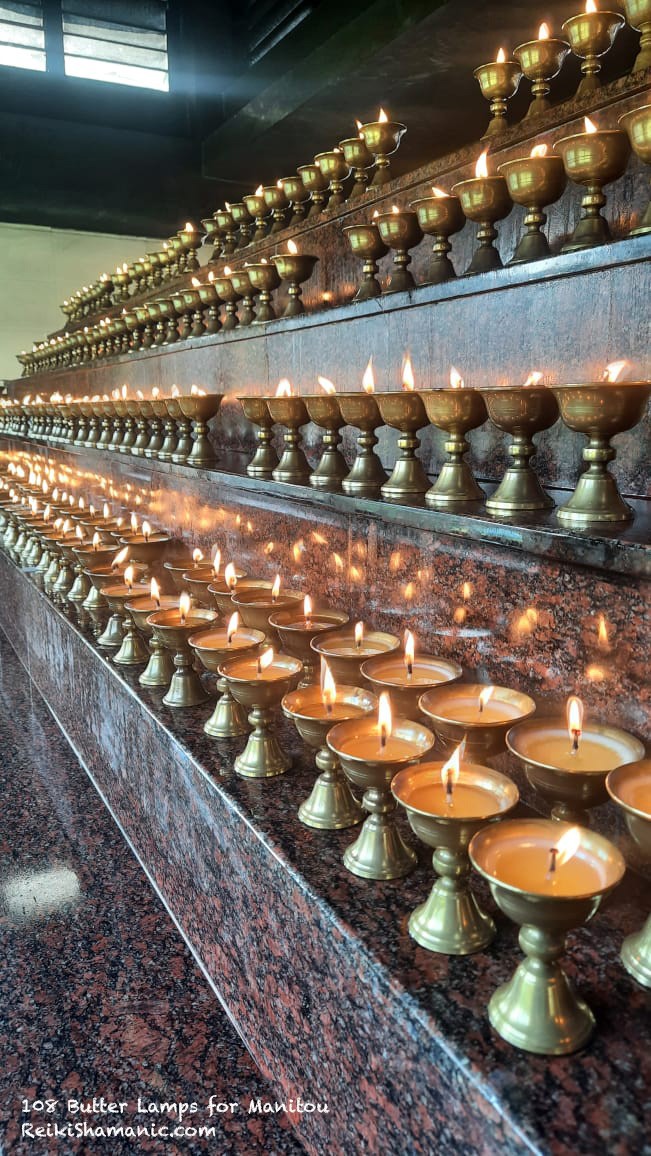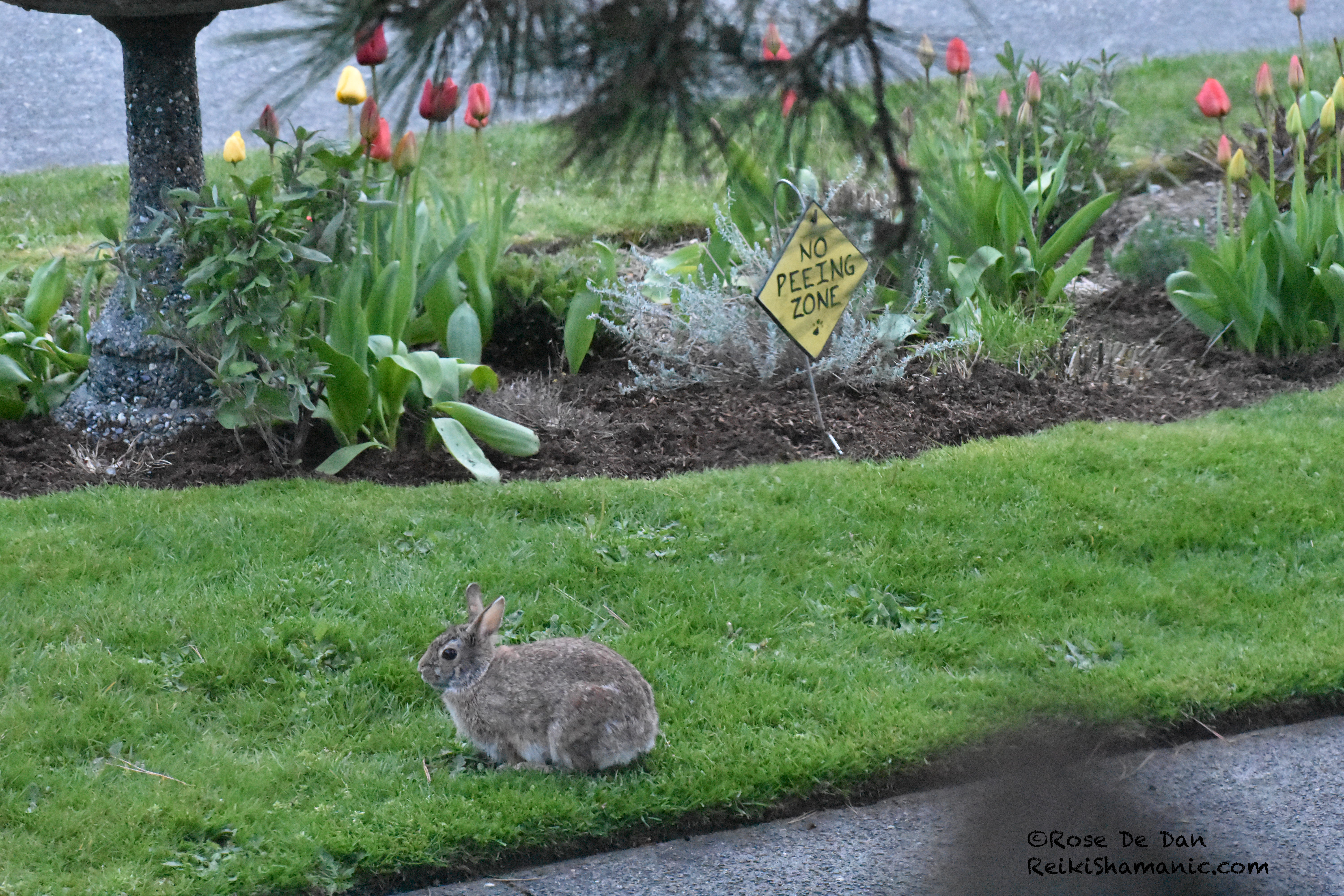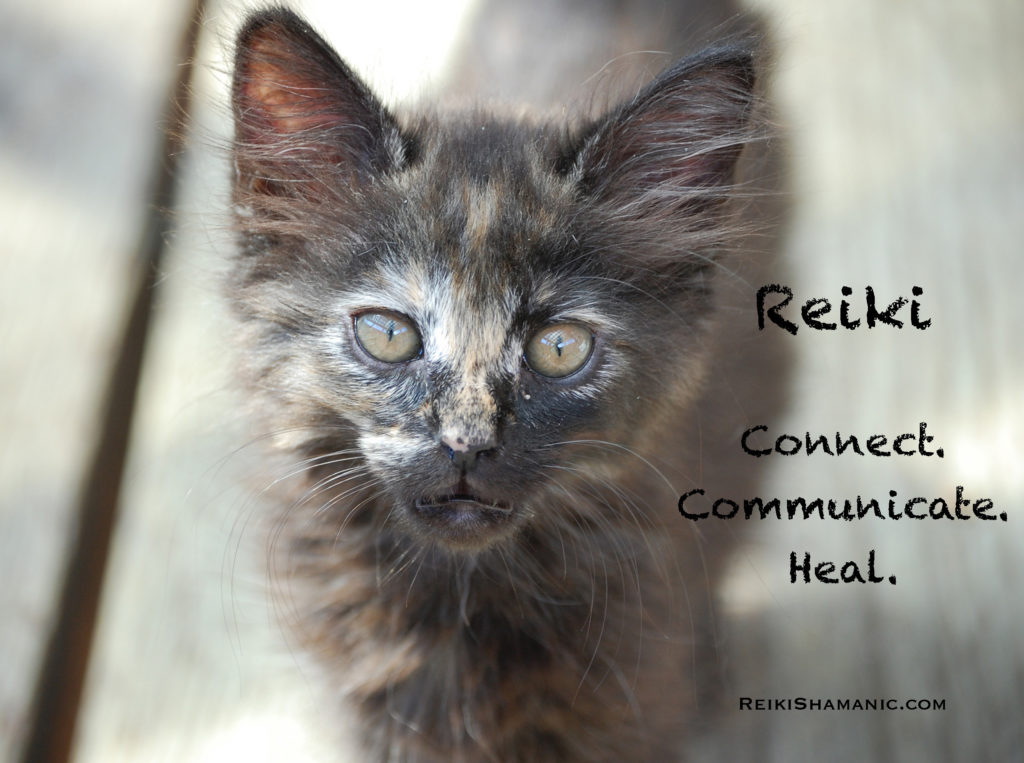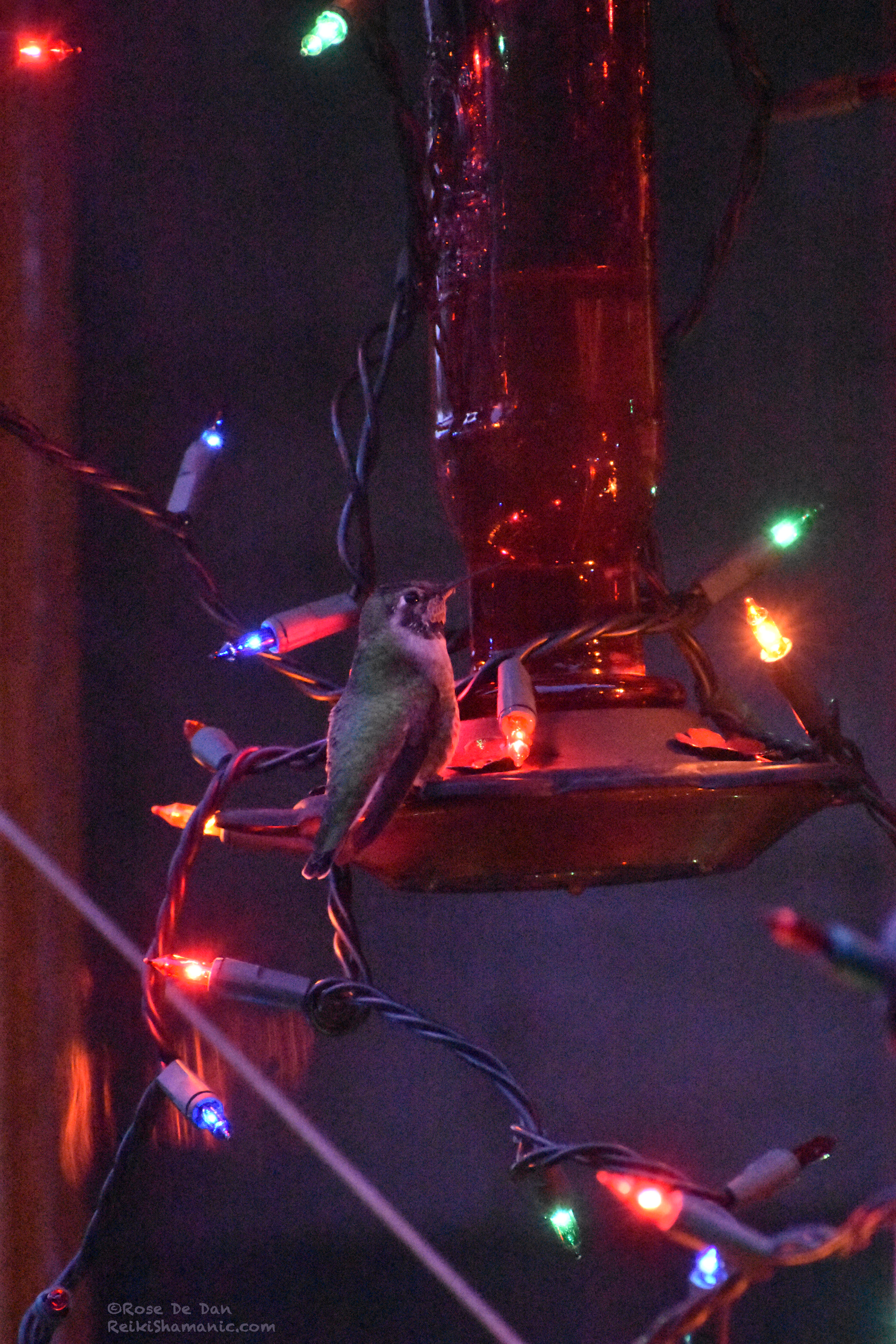
The Hummingbird Chronicles
Here in Seattle, Anna’s hummingbird overwinters rather than migrating. Our winter temps don’t normally go below freezing, so they still have access to winter blooming flowers and insects. However, a hummingbird feeder can be an important supplement. If temps do drop below freezing a nectar feeder can literally be a lifesaver. The trick is how to keep the sugar water from freezing? This week with temps dropping into the high teens AND inches of snow (freaky for Seattle) my resident male Anna’s Hummingbird and I explored how the Wild Rose Café (aka my home office) could best support him through these challenging times.
December 26, 2021
In photo above, my resident male Anna’s hummingbird visits at dusk for a last feed before tucking in for the night. I had added the mini Christmas lights in hope that they would be enough to keep the nectar from freezing.
I got up before dawn today to check on the nectar. We’ve had snow showers, and the temp will drop to a low of 22 degrees. I am worried that the mini lights may not be enough to keep the nectar from freezing. [They helped, but were not warm enough to be reliable overnight. However, Hummingbird does love the colors, so the festive decorations are staying, lol.]
Hummingbirds need to feed every 15 minutes, and they feed most heavily when they first wake and before retiring for the night. I may have to set my alarm for pre-dawn to be sure the nectar is not frozen. I have extra feeders I can rotate so that there is always one thawed. It may be a busy week…
UPDATE: I remembered that I have a special hummingbird feeder heater, and set it up. We’ll see how that works!
For those who might be wondering about the woman behind the camera, the wildlife cam accidentally documented my taking this photo. I first spotted Hummingbird on the wisteria—a favorite perch—but he immediately flew down to the feeder. He was cooperative with being the subject of attention, graciously posing and taking sips of nectar. His stillness (a rarity) enabled me to get that photo of him amongst the Christmas lights.
December 27, 2021
A few more photos of my resident male Hummingbird during snowfall from yesterday and today’s hummingbird report.
The first two photos were taken from my office window which overlooks the Wild Rose Cafe. Hummingbird has claimed the branch as his lookout post for the smaller feeder. That area is also more protected from the wind than the feeder in the backyard.
The last two are of that larger feeder by the back door. When I checked the feeder this morning (temp was reported as 19 degrees, but feels like 7!) the upper portion of the nectar was frozen, but the bottom area was still liquid. The hummingbird feeder heater was working! I may try covering the upper part of the feeder with a sock or some bubble wrap and see if that helps. I also will see if I have a 15-watt bulb. They say you can replace the existing 7-watt if temps are colder.
I replaced both feeders before dawn. I smiled to hear Hummingbird just now as I am typing and went to take a look. He was happily enjoying breakfast at the feeder and is now sitting on his branch cheerily announcing his presence to the world (still too dark for a photo). Love that mighty mite. So small, so fierce, and able to survive below freezing temps dressed in feathers—remarkable!
UPDATE: Just now I went outside with a replacement for the small feeder which had already frozen up in an hour. Before I could hang the one I was carrying Hummingbird approached and drank from it while I spoke softly to him. Touched my heart. Trust.
December 28, 2021
Yesterday I experimented with covering the hummingbird feeder with a wool leg warmer to keep it from freezing overnight. I did this while it was still light so that I could see if my resident male hummingbird would accept the new idea. When he saw what I was doing, Hummingbird hurried over in a flurry of wings and loud vocalizations. From all of that, I gathered he was wondering, “What the heck are you doing to MY feeder?”
I took care to explain the why and he settled down. As soon as I finished he came to the feeder to investigate more closely. After a few tentative darts, he settled down and had some nectar. He grumbled a bit as it was not an aesthetically pleasing look, but I think we can both agree that if it works the result would be worth the sacrifice.
In looking at my handiwork I had to laugh—wrapped with a black leg warmer from my college days, and lit with the red heater below, the feeder reminded me of the infamous black fishnet stocking leg lamp from the movie A Christmas Story!
I got up this morning pre-dawn to check, and despite temps in the teens and snow showers, the nectar was still liquid. The combination of the heater below and the leg warmer insulated glass had worked!
A little later I put the smaller feeder out (I keep that one inside overnight while he is sleeping because it freezes up quickly), and saw Hummingbird huddled up, dozing on the pine tree branch. It was still very early.
After I went back inside, he roused himself to come to the feeder. Rather than taking a perch, he “sipped” his way around the rim of the feeder. It seems like more work to me, but it is something I’ve seen him do a lot lately. Again, I flashed back to the Christmas movie and wondered if Hummingbird was ever in danger of freezing his tongue to the surface. The feeder is plastic, so I think he is safe. [Their tongues can freeze to nectar that is frozen, see this video.)
Love the icicles, another cold, snowy day…may All My Relations stay safe and well!
December 29, 2021
Snow continuing from last night. Temps still below freezing, but there is hope for them continuing to rise this week.
Got up before dawn again to check on large feeder and put out smaller one. I heard my resident male Anna’s Hummingbird before I saw him. He seems to like the new nectar just fine, which is reassuring.
Yesterday I discovered that I was not supposed to feed him organic sugar and why. I had originally thought how could organic sugar possibly be different from regular other than how the cane sugar is grown?
What I learned is that organic sugar does not go through the chemical refining process that removes minerals like iron which can be toxic to hummingbirds over time. Oh, no!
I panicked. I was not able to get to the store, so I called neighbors asking to borrow a cup of sugar (how cliche, lol). One baker had exhausted her supply with Christmas baking, another used organic, too.
Thankfully, my baking neighbor called back and said she needed groceries, could she pick me up some regular refined white sugar? Yes, please!
Gratitude for the help from the village to keep one mighty Hummingbird supplied with the literal nectar of life in the midst of a cold, snowy Seattle week!
Resources and Tips for Feeding Hummingbirds
• Feeding Hummingbirds in Cold Weather
• 11 DIY Ways to Keep Hummmingbird Nectar from Freezing
• Hummingbird Central: A friend in Port Orchard, WA is making nectar by the gallon!
• Hummingbirds Feeding on TikTok
>>>>>>
Learn how to connect more deeply with animals, restore balance to your life, increase intuitive skills, and help heal the Earth with live Reiki and shamanic teleclasses, available worldwide.
>>>>>>
SHARE THIS ARTICLE
You are welcome to share this article with others by email, on your blog or to your mailing list so long as you leave it intact and do not alter it in any way. All links must remain in the article. And, you must include the copyright notice and the bio.
©2021 Rose De Dan. All Rights Reserved. www.reikishamanic.com
A WILD WAY TO HEAL
Rose De Dan, Wild Reiki and Shamanic Healing LLC, is an animal communicator, Reiki Master Teacher, shamanic energy healer, and author. Her classes, sessions, and ceremonial work are inspired by wild and domestic animals who have issued a call to action for personal and global healing.








